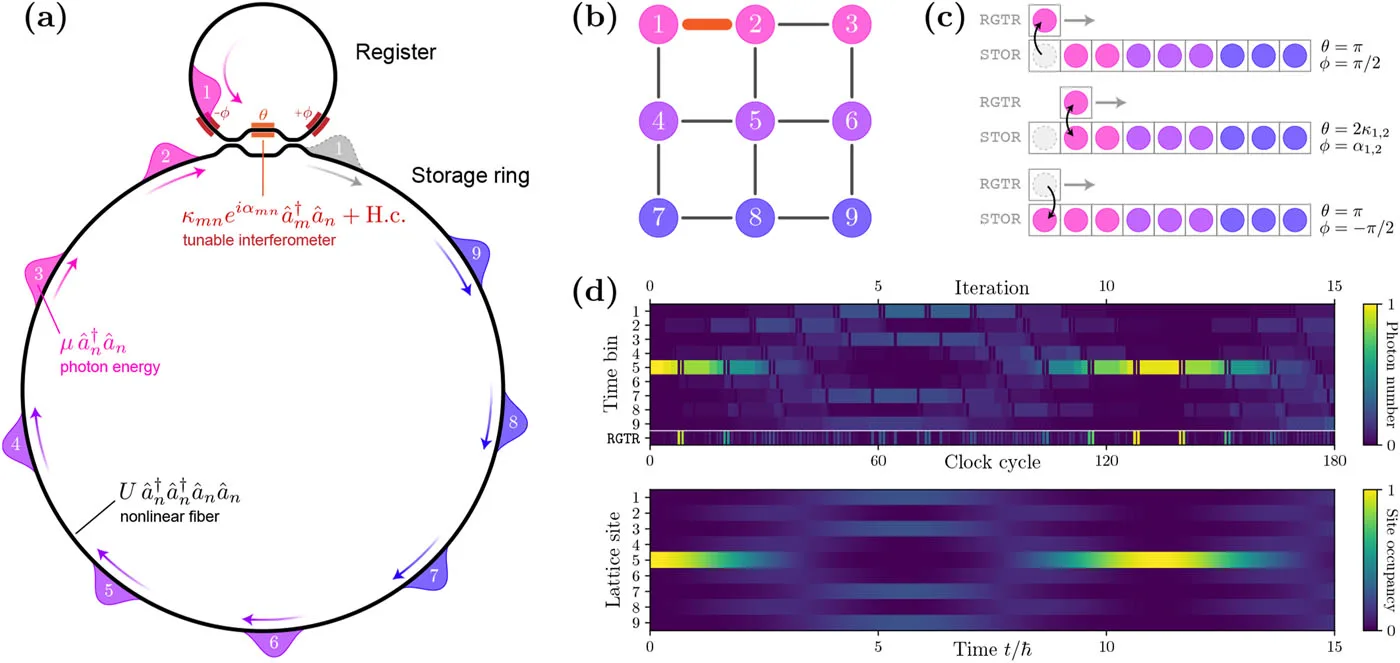Researchers from Stanford University, the University of Maryland, and the National Quantum Laboratory at Maryland have developed a programmable photonic device that can simulate a broad class of Hamiltonians in lattices with arbitrary topologies and dimensions. The device uses a synthetic time dimension to emulate physical phenomena such as chiral states in a Hall ladder, effective gauge potentials, and oscillations in high-dimensional lattices. This advancement could open new possibilities for studying topological and many-body physics, and has potential applications in quantum magnetism, high-temperature superconductors, and magnetic insulators. However, the device is still in the theoretical stage and requires further research and development.
What is the Programmable Photonic System for Quantum Simulation in Arbitrary Topologies?
The article discusses a programmable photonic device that can simulate the dynamics of a broad class of Hamiltonians in lattices with arbitrary topologies and dimensions. The device was developed by a team of researchers from the Department of Applied Physics at Stanford University, the Department of Mechanical Engineering and Institute for Physical Science and Technology at the University of Maryland, and the National Quantum Laboratory at Maryland. The device is capable of emulating a wide variety of physical phenomena, including chiral states in a Hall ladder, effective gauge potentials, and oscillations in high-dimensional lattices.
The concept of synthetic dimensions in photonics has generated significant interest in the field of topological physics. Synthetic dimensions are formed by controlling couplings between degrees of freedom of a system, either by repurposing the usual geometric dimensions such as space or time, or by augmenting these dimensions with internal degrees of freedom such as frequency, spin, or orbital angular momentum. Since couplings in synthetic dimensions can be dynamically reconfigured and are not fixed by a physical structure, they can scalably implement high-dimensional lattices with complex topologies, making this an ideal platform for quantum simulation.
How Does the Programmable Photonic Device Work?
The programmable photonic device works by simulating the dynamics of interacting bosons in lattices with arbitrary dimensions, topologies, and connectivities using a synthetic time dimension. A large class of prototypical condensed matter Hamiltonians can be described by local two-body interactions on an arbitrary lattice. This class of Hamiltonians, which includes tight-binding models, the Hubbard and Bose-Hubbard models, and their various extensions, can in general be described using a specific formula.
The device emulates the dynamics of the Hamiltonian using a synthetic temporal dimension. The design consists of a waveguide loop exhibiting Kerr nonlinearity, the storage ring, in which a train of single-photon pulses propagates in a single direction with each pulse occupying its own time bin. A second loop, the register, is connected to the storage ring using a Mach-Zehnder interferometer (MZI) with two tunable phase shifters. The hardware of the device is chosen to emulate each term of the Hamiltonian with dedicated components.
What are the Applications of the Programmable Photonic Device?
The programmable photonic device opens new possibilities for studying topological and many-body physics in near-term experimental platforms. The general class of Hamiltonians that the device can simulate exhibits rich phase diagrams and relates to quantum magnetism, high-temperature superconductors, and magnetic insulators, among many other applications.
The device’s approach is distinct from those of existing experimental demonstrations and theoretical proposals for the simulation of such Hamiltonians, which include ultracold atoms on optical lattices, trapped ions, and superconducting qubits. The device can create arbitrarily shaped lattices in higher dimensions through active modulation control, whereas other architectures need physical modifications to increase dimensionality or change the connectivity of the lattice.
What is the Future of the Programmable Photonic Device?
The programmable photonic device represents a significant advancement in the field of quantum simulation. Its ability to emulate a wide variety of physical phenomena and simulate the dynamics of a broad class of Hamiltonians in lattices with arbitrary topologies and dimensions makes it a powerful tool for studying topological and many-body physics.
However, the device is still in its theoretical stage, and further research and development are needed to fully realize its potential. The team of researchers is optimistic about the future of the device and believes that it will open new possibilities for studying topological and many-body physics in near-term experimental platforms.
Publication details: “Programmable photonic system for quantum simulation in arbitrary topologies”
Publication Date: 2024-02-23
Authors: Ben Bartlett, Olivia Y. Long, Avik Dutt, Shanhui Fan, et al.
Source: Deleted Journal
DOI: https://doi.org/10.1063/5.0181151

